| THIS WEEK'S ARTICLES |
| John Murphy's Market Message |
| OVERSOLD STOCK INDEXES ATTEMPT TO STABILIZE NEAR CHART SUPPORT |
| by John Murphy |
OVERSOLD MARKET ATTEMPTS TO STABILIZE... After an incredibly volatile week of trading, stocks are in a short-term oversold condition and attempting to stabilize near chart support. Chart 1 shows the Dow Industrials stabilizing near a flat support line drawn under their June low. At the same time, the 14-day RSI line in the upper box is bouncing from oversold territory near 30. The Dow, however, remains below its 200-day moving average, however, which casts the current rebound in a more negative light. Chart 2 shows a similar situation in the S&P 500 which is attempting to stabilize near its October low while being in a short-term oversold condition. The SPX is also trading below its 200-day moving average. The Nasdaq is the weakest of the three major indexes but is also attempting a short-term rebound. Chart 3 shows the Nasdaq Composite Index trading well below its October low, but finding some short-term support near its May low. The COMPQ is also the furthest from its 200-day moving average. So far, this week's rebound is modest in nature and hasn't been enough to repair technical damage done during the month of January. That damage can be seen more clearly in various measures of market breadth.
 Chart 1 Chart 1
 Chart 2 Chart 2
 Chart 3 Chart 3
ADVANCE-DECLINE LINES BREAK CHART SUPPORT... Shown below are two different measures of market breadth and both paint a negative picture. Chart 4 shows the more traditional version of the NYSE Advance-Decline line breaking support formed during the second half of 2021 and falling to the lowest level since last May. Chart 5 shows the NYSE Common Stock Only Advance-Decline line also breaking chart support and falling to the lowest level since last March. Those advance-decline lines have a history of leading stock indexes lower at market tops.
 Chart 4 Chart 4
 Chart 5 Chart 5
MOST SPX STOCKS FALL BELOW 200-DAY LINES... Chart 6 shows another measure of market breadth trending lower. The solid line shows the percent of S&P 500 stocks trading above their 200-day average falling to the lowest level since the middle of 2020. It also fell to 45% yesterday which means more than half of S&P 500 stocks have fallen below their 200-day lines. That's another technical sign that the major trend for stocks has suffered a lot of damage. And provides another reason why the current oversold rebound needs to be viewed in that longer-range negative context.
 Chart 6 Chart 6
|
| READ ONLINE → |
|
|
|
| ChartWatchers |
| C'mon Commodities, Push That Energy Sector UP! |
| by Julius de Kempenaer |

Watchers of my show Sector Spotlight will know that I have been watching the development of commodities as an asset class that's going through a long turnaround. Recent developments continue to reinforce that view.
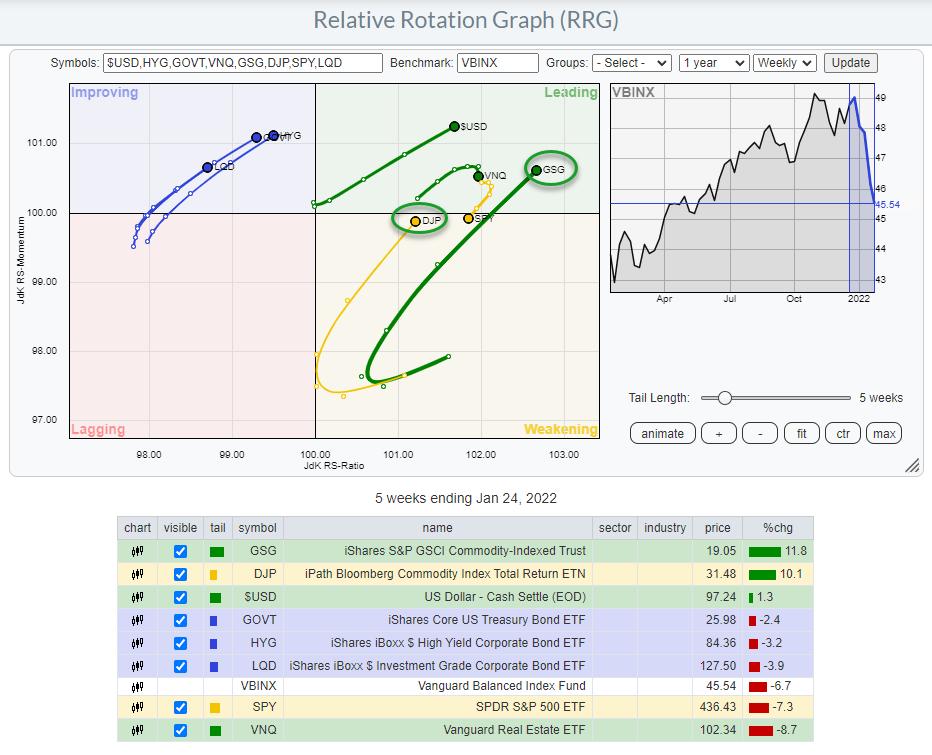
The Relative Rotation Graph shows the rotation for a universe of asset class ETFs vs. VBINX, the Vanguard Balanced Index Fund. The longest tails are for GSG and DJP, the two commodity ETFs that I track on this RRG/Universe. These tails entered the leading quadrant in September/October 2020 after coming from a long rotation through improving, after a multi-year period of underperformance.
Almost immediately after entering the leading quadrant, these tails started to roll over downward and lose relative momentum. That recovery from the depths of relative strength was taking its toll and needed time to refuel. In December '20/January '21, the tails curled back up and entered the leading quadrant at a strong RRG-Heading, setting off a new leg higher in the just-established relative uptrend. That process repeated again from April to October, when both tails once again rotated back into the leading quadrant from weakening, again at a strong RRG-Heading, and then again from November until now.
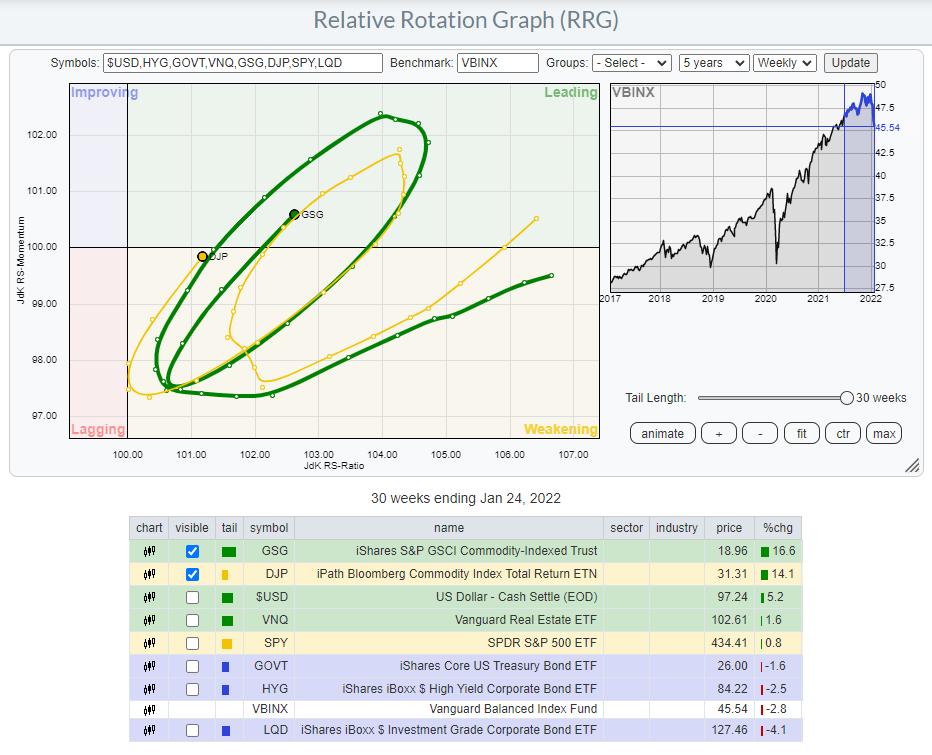
Once again, the DJP and GSG tails are entering the leading quadrant from weakening, underscoring the strong relative uptrend that is going on.
DJP
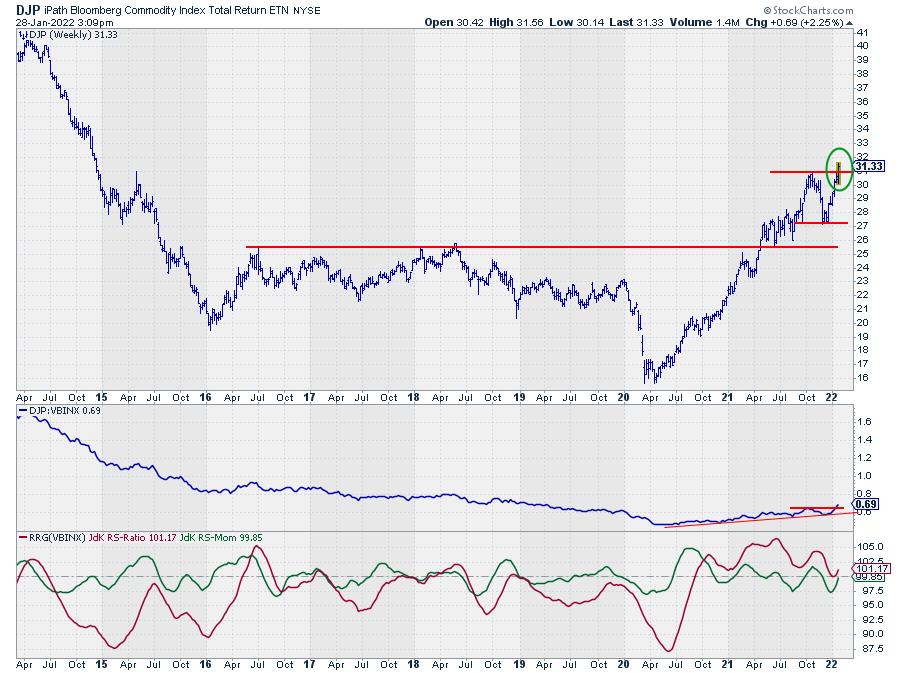
GSG
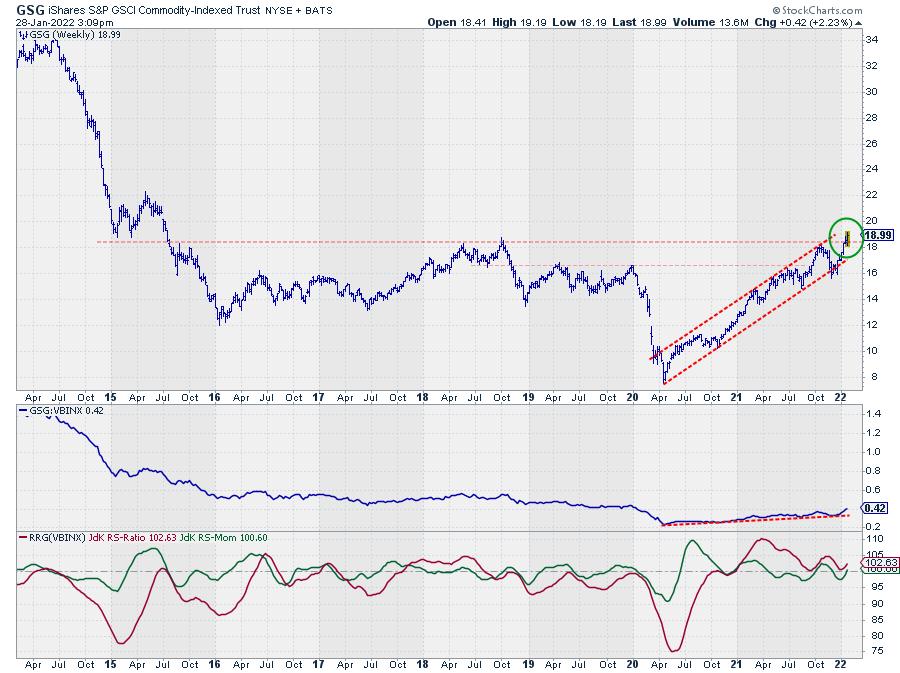
Both DJP and GSG are showing breakouts above major resistance levels this week, which opens up the way for much more upside movement in this asset class.
In the drop-down list on the RRG page, we also have an RRG universe for Commodity groups that allows us to go into the breakdown of the commodity universe.
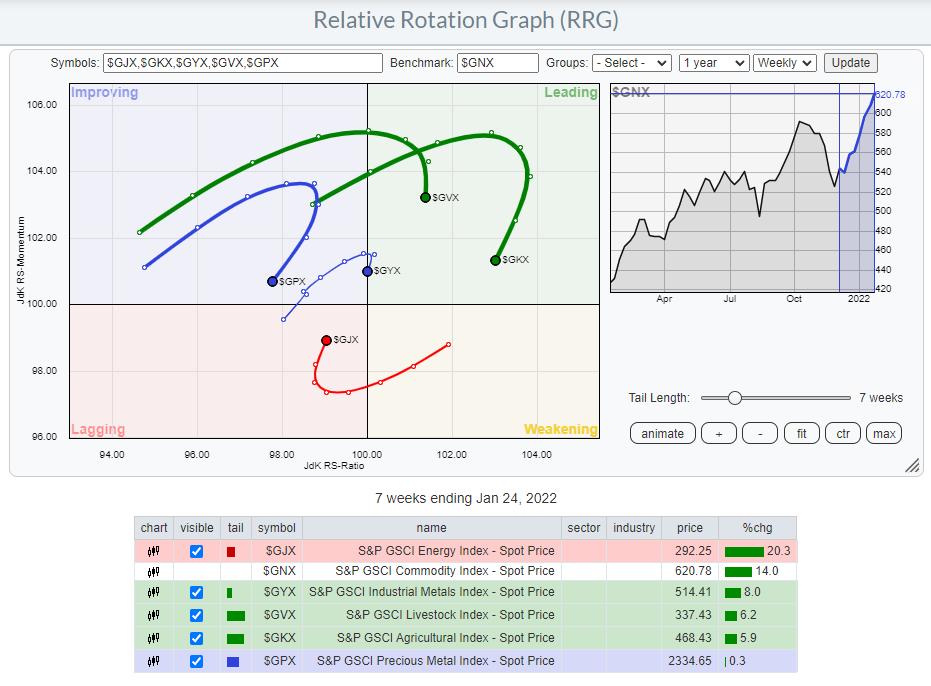
What we see here is an interesting rotation between the different commodity groups. The tails are seven weeks long and, at the moment, only $GJX (Energy) is turning back into the 0-90 degree heading, while all other groups are turning in the opposite direction. What this means is that, until now, the rally in commodities has been driven by all groups except energy. That is now changing.
It looks as if Energy will be the group driving the next wave higher for commodities.
S&P GSCI Energy Index
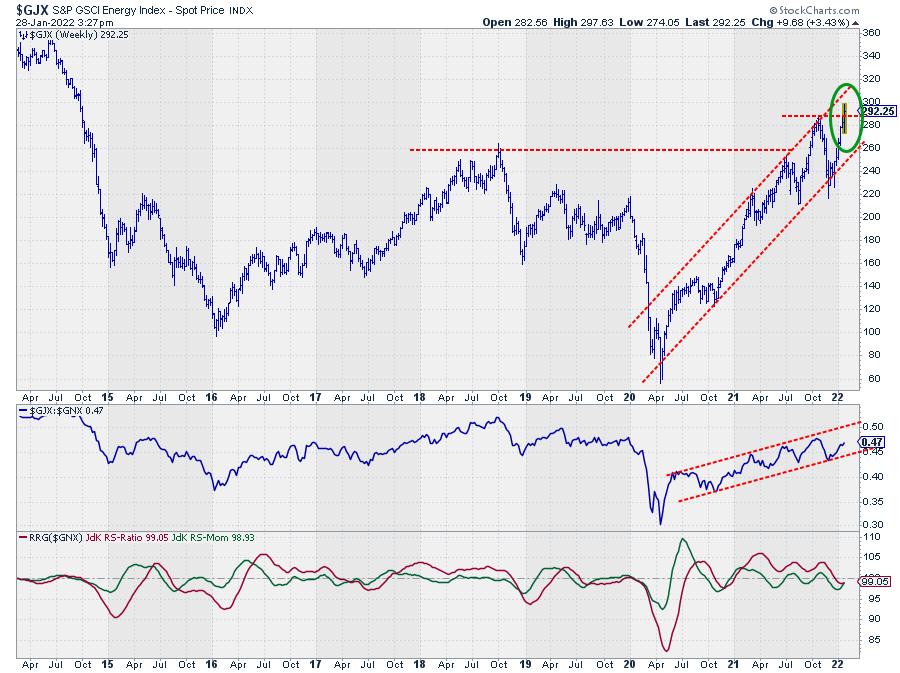
The price chart of the underlying Energy index is supporting such a rotation, as it is just taking out its previous high and setting up to continue its rally higher. Making a connection to the stock market brings us to the chart of the Energy sector index.
XLE
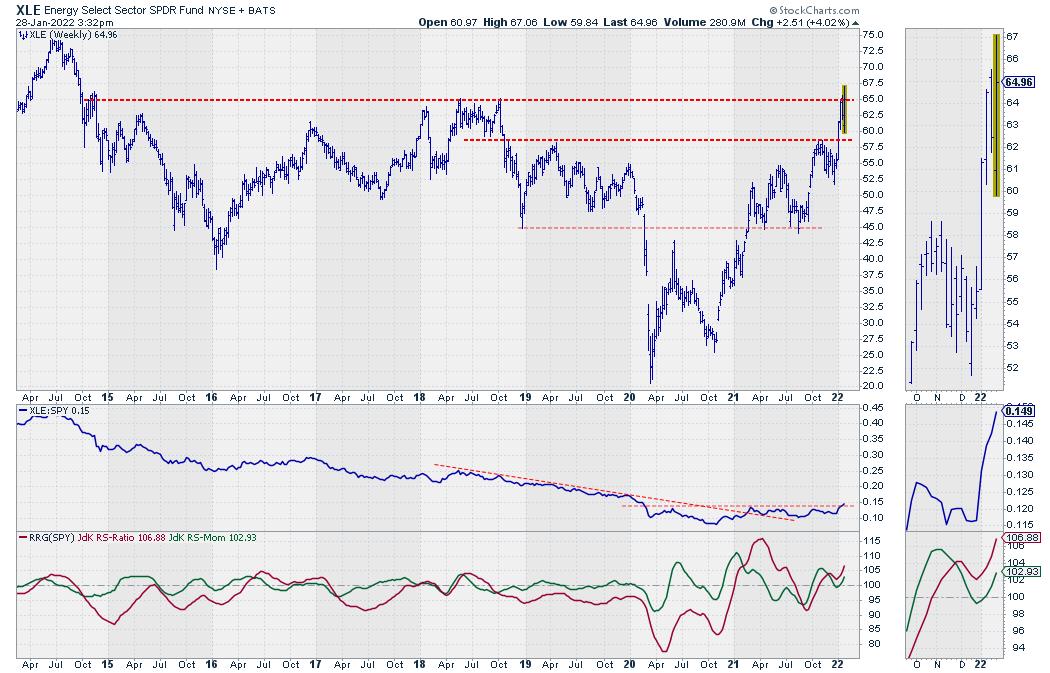
Here, we also see an attempt to take out a major overhead resistance level. This week, it was too much and XLE failed just short of 65.
When $GJX will be able to follow through on this week's upward break, it seems only a matter of time before XLE will follow in its tracks and push higher as well.
#StaySafe and have a great weekend, --Julius
My regular blog is the RRG Charts blog. If you would like to receive a notification when a new article is published there, "Subscribe" with your email address.
|
| READ ONLINE → |
|
|
|
| Martin Pring's Market Roundup |
| Some Indexes Break Down from Major Price Patterns: Selling Climaxes Offer Hope! |
| by Martin Pring |
I am a great believer in the principle of false breaks being followed by above-average moves in the opposite direction to the break. It happens because those who bought on it are caught on the wrong side of the market and are forced to re-position themselves, just as correctly positioned traders start stepping up their buying or selling, depending on the direction of the break. In that respect, I wanted to start off by presenting a classic example using recent action by the S&P, as well as later showing you an example currently developing in real time.
The initial example is is presented in Chart 1, where you can see that a perfectly valid S&P upside break from an inverse head-and-shoulders failed to hold. False breaks or whipsaws need to be confirmed. In this instance, you can see a negative 50-day MA crossover, but, more importantly, a violation of the dashed trendline joining the head with the right shoulder and the more conservative solid line. The false break was followed by the 2022 January selloff, which has already proved to be an above-average move.
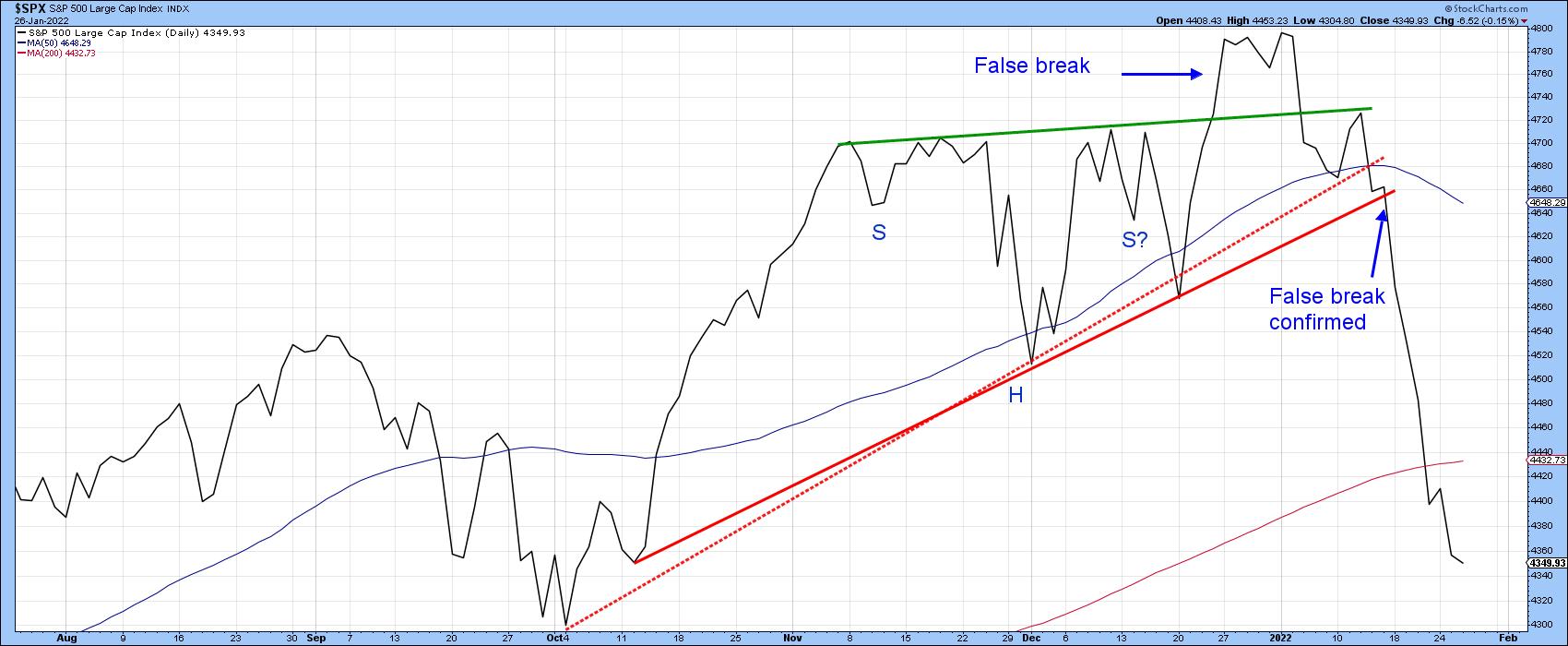 Chart 1 Chart 1
That's history, of course, so what are the indicators telling us now? First and foremost, Chart 2 indicates that recent action pushed the Dow back to support. In this instance, it was the lower boundary of a broadening wedge. At market peaks, these formations are characterized by two diverging trendlines that develop in the direction of the prevailing trend. This diverging action underscores the fact that the technical position is gradually becoming more and more unstable and is why, when completed, these formations are often followed by above-average declines. The words "when completed" have been emphasized, because a price pattern that has not experienced a breakout is not a price pattern, merely a potential formation, as is this one. That said, note that volume has expanded incredibly this week and dwarfs anything seen since 2020.
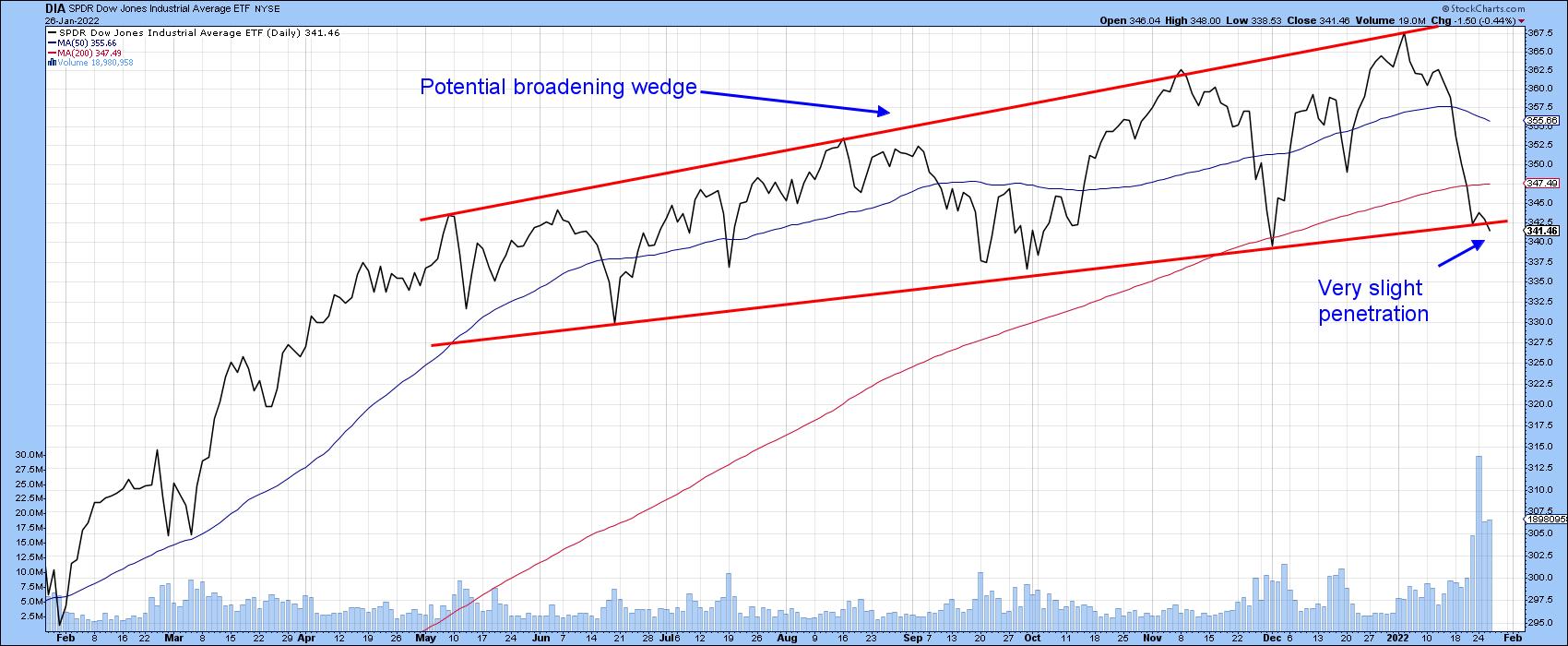 Chart 2 Chart 2
Chart 3 puts this in perspective by featuring the PVO, where six of the last seven selling climax peaks were followed by a rally. That action does not necessarily indicate the low for the move, but certainly suggests a slowing of downside momentum and possible avoidance of the pattern completion if, in fact, it has peaked for this move.
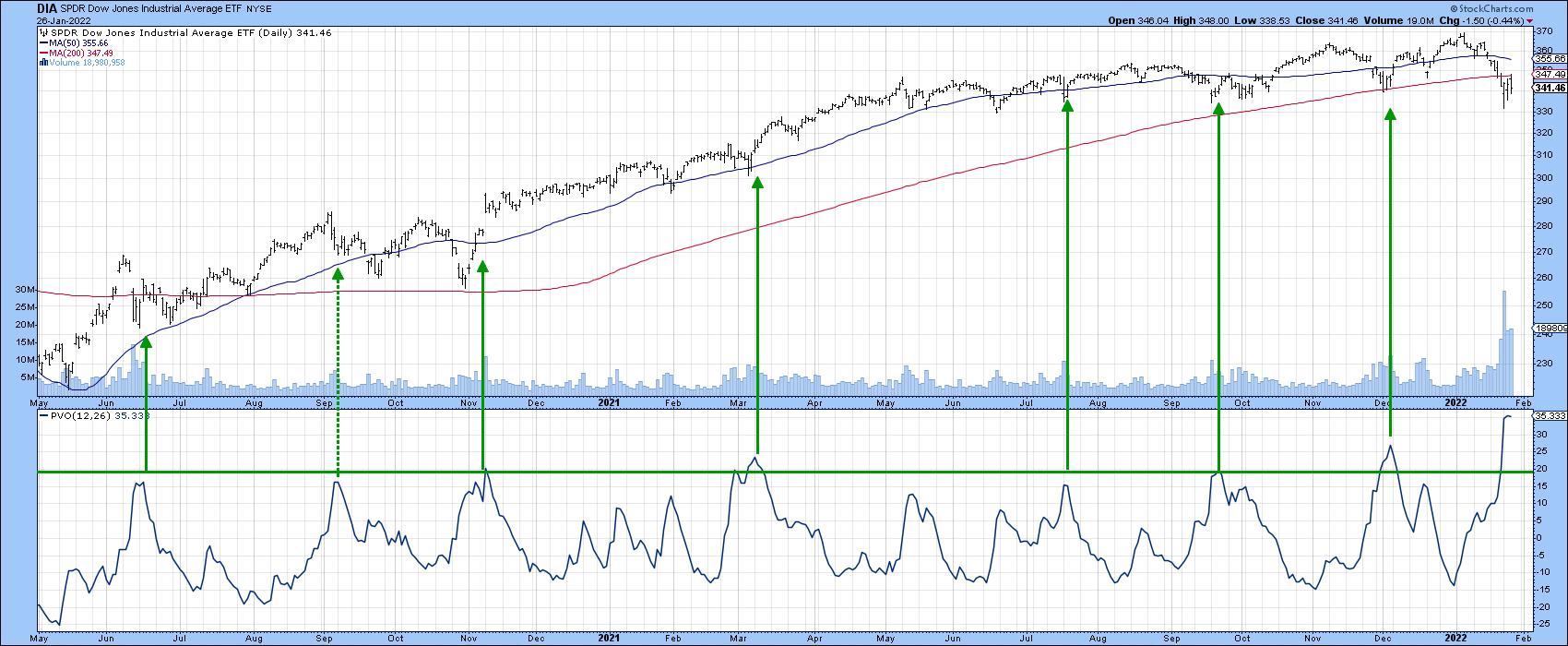 Chart 3 Chart 3
One reason to be cautious here is that my Dow Diffusion indicator, featured in Chart 4, is quite some ways from registering an oversold reading. This indicator calculates the percentage of Dow stocks in a positive trend and usually drops to some kind of oversold reading at an important bottom, as flagged by the green arrows. Note that, in the last few years, no significant rally following a selloff has been launched without oversold help from the Dow Diffusion indicator.
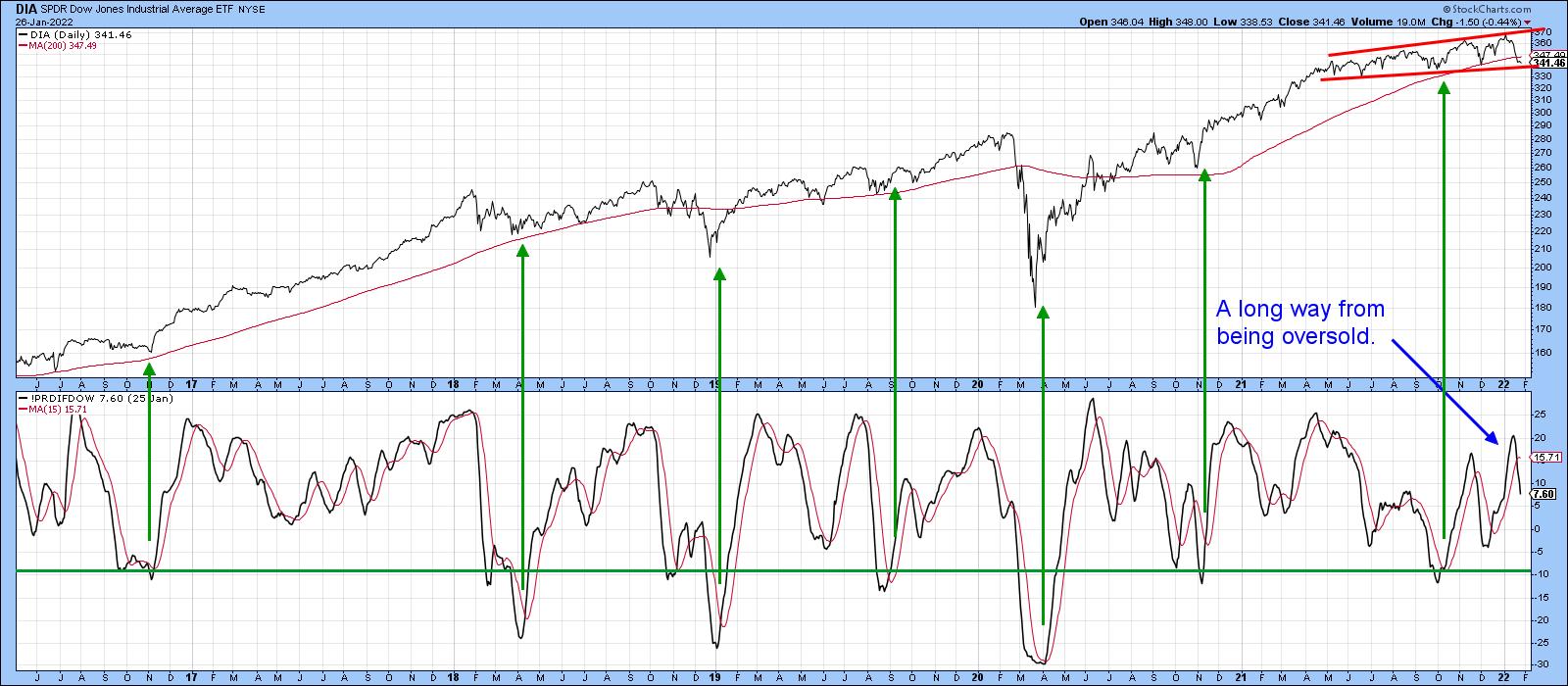 Chart 4 Chart 4
Several other averages are also above critical chart points. Chart 5 points out that the Common Stock A/D Line is right at the base of a possible top. Note that the NYSE A/D Line has already completed a top of its own, following its failure to confirm the most recent S&P high.
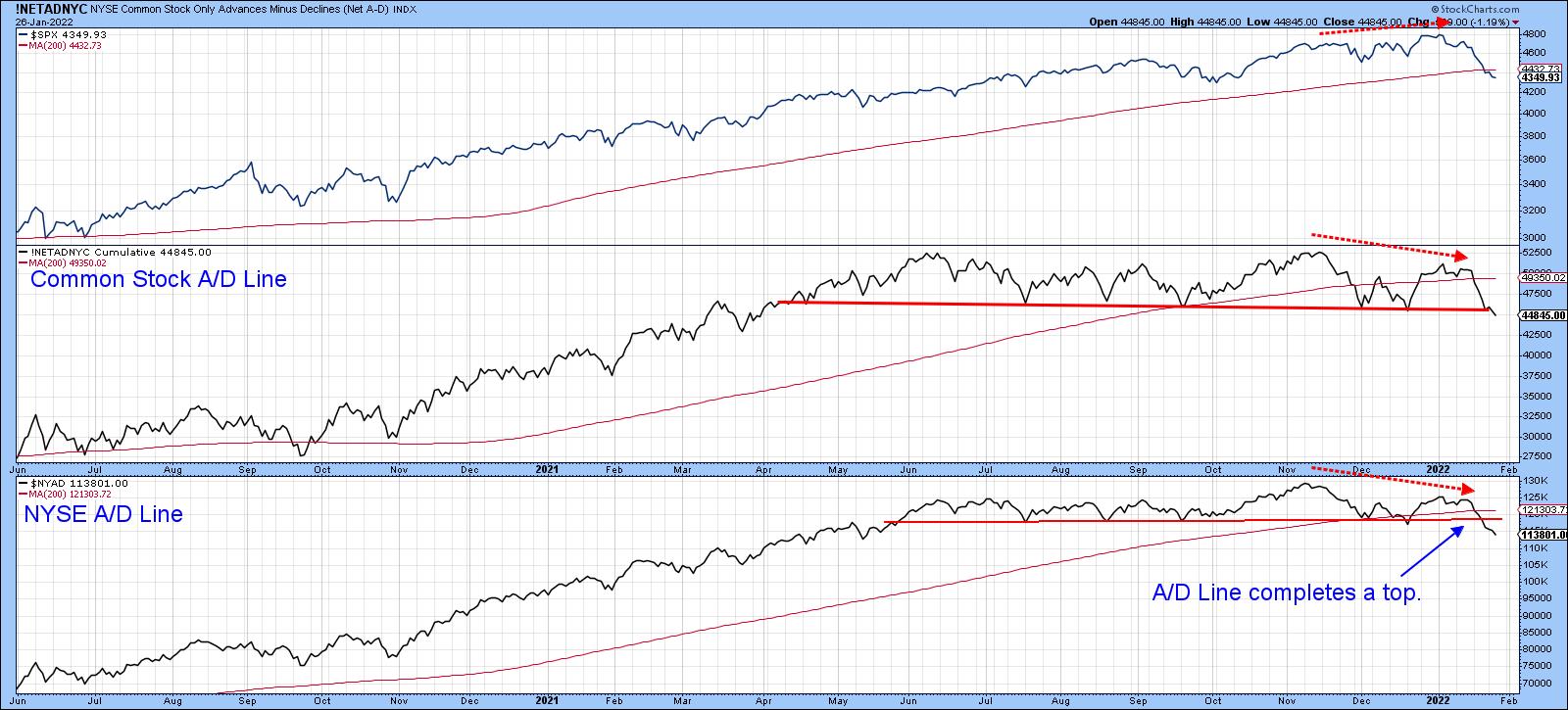 Chart 5 Chart 5
An even greater divergence is being presented between the NYSE Percent of Stocks Above Their 200-Day MA and the NYSE Composite (Chart 6). The indicator peaked at the beginning of 2021, about a year ahead of the Composite. As a result, barely 50% of NYSE Issues were trading above their 200-day MAs when the Index touched its all-time high at the beginning of the year. The indicator has just dropped to a new low, right at the time the Index is approaching the base of a potential broadening formation with a flat bottom. The implication is that it is leading the NYA lower.
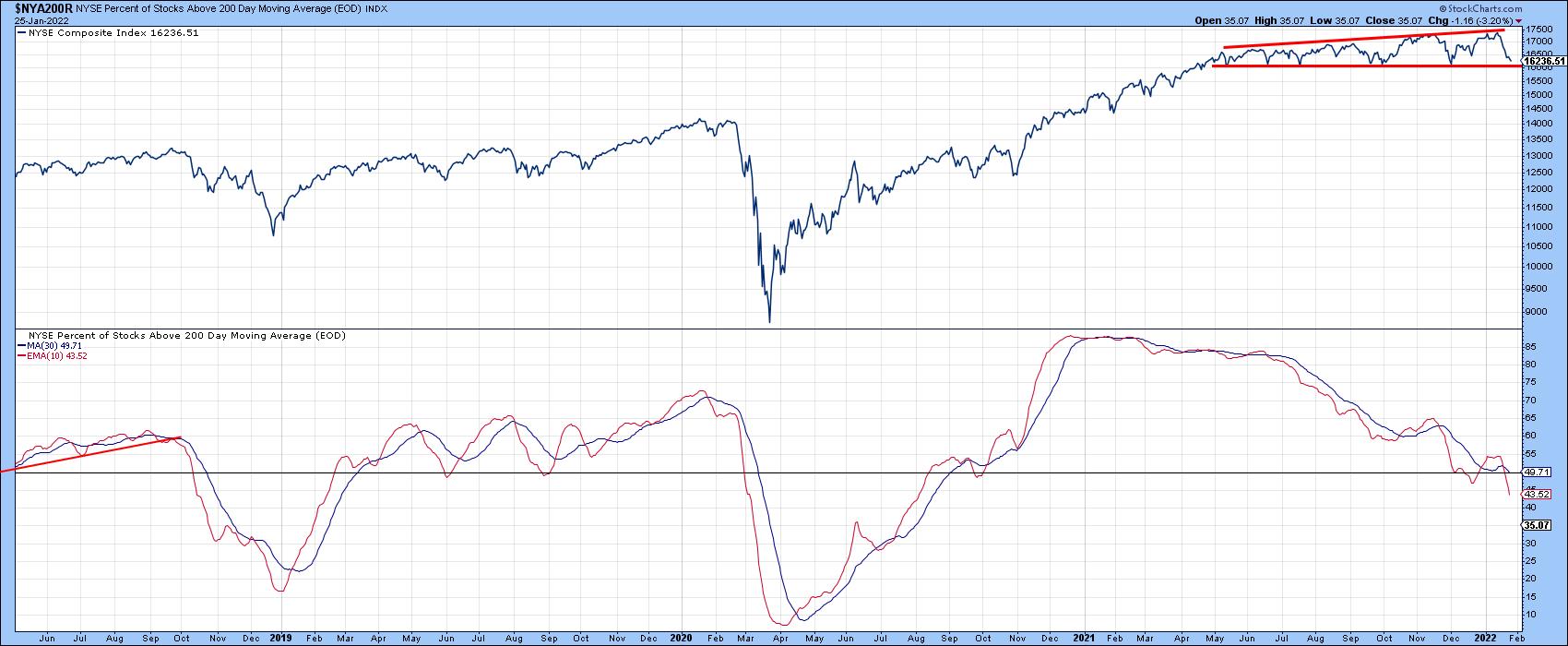 Chart 6 Chart 6
Chart 7 sets the scene for the whole world, as the MSCI World Stock ETF (ACWI) has already completed a broadening wedge and penetrated its 200-day MA. Speaking of false breakouts, my Global A/D Line, constructed from a universe of individual country ETFs, experienced a whipsaw move to the upside right at the beginning of the year. It is just starting to confirm the upside move as being false, as it now edging though its 2021 support trendline and is right at its 200-day MA. It may already be through, though, as Wednesday's down day is not reflected in the latest plot. Please remember, it's always possible to update any of these charts by simply clicking on them when that new data is available.
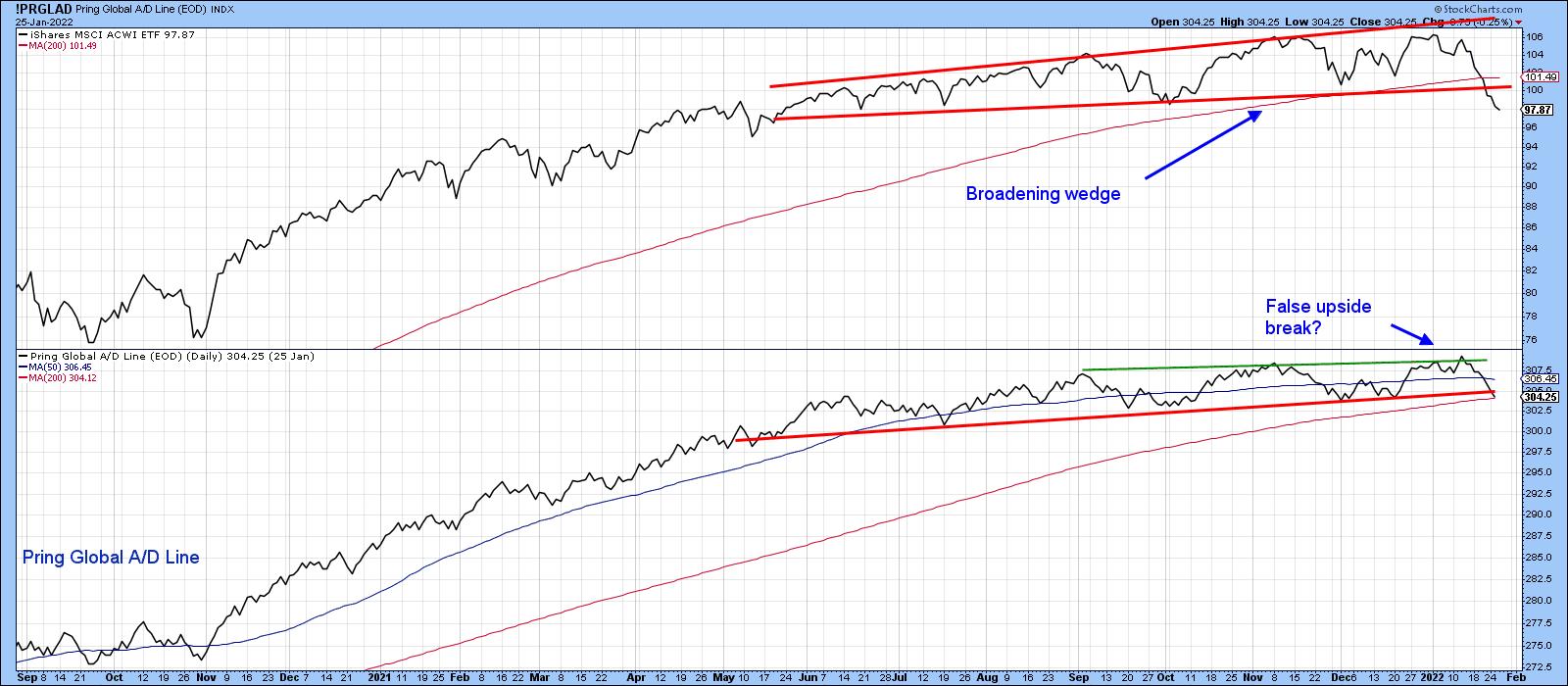 Chart 7 Chart 7
Conclusion
Several market averages have fallen to key support at a time when many are also experiencing selling climaxes. Normally, this kind of condition is followed by a rally or basing period, but other indexes, including the World Stock ETF, Wilshire 5000 and Russell Small Cap ETF, have already broken to the downside. While a relief rally may well develop, now is not the time to be playing hero. Better to take risks at higher levels when the dust has settled.
Good luck and good charting,
Martin J. Pring
The views expressed in this article are those of the author and do not necessarily reflect the position or opinion of Pring Turner Capital Group of Walnut Creek or its affiliates.
|
| READ ONLINE → |
|
|
|
| The Traders Journal |
| Sushi Investing: The Secret To Producing Profits Before The Expiration Date (Part 1) |
| by Gatis Roze |
 Profits are the product of practicing a persistent pilgrimage towards perfecting your sell disciplines. To paraphrase a sports cliche, without an exceptional defense you won't win championships. Michael Jordan has unequivocally stated that without the defensive wizardry of Dennis Rodman, the Chicago Bulls would not have been world champions in 1996, '97 or '98. Profits are the product of practicing a persistent pilgrimage towards perfecting your sell disciplines. To paraphrase a sports cliche, without an exceptional defense you won't win championships. Michael Jordan has unequivocally stated that without the defensive wizardry of Dennis Rodman, the Chicago Bulls would not have been world champions in 1996, '97 or '98.
The analogy to profitable investing is crystal clear. On your personal team, your portfolio is always dependent upon a strong sell methodology. In my own 30 years of investing and trading, I've personally embraced a number of sports metaphors with rewarding results. This NBA basketball example is one of my favorites.
Back to our "take action" type of guy as Michael Jordan referred to Dennis Rodman. Even Phil Jackson - the Zen Master coach of the Bulls — admitted that it was profoundly difficult for him to accept the fact that the Bulls needed Rodman who had a reputation as being difficult and high maintenance. Jackson did, however, finally acknowledge Rodman's unusual skill set and that it was exactly what the Bulls needed. The Chicago Bulls organization was also banking on Coach Jackson's special coaching skills to make it all come together.
Against all norms at the time, Coach Jackson allowed Dennis Rodman to miss practices. Jackson embraced the reality that Rodman was a unique and different kind of player. While the team did drills on the court, Rodman spent his time pouring over films of his adversaries before each game. This was the brilliance of a defensive savant who was arguably one of the greatest defensive players in NBA history. Lost in the media focus on his tattoos, piercings and parties is the fact that Rodman researched in exhaustive detail and in great depth every adversary he was about to face — including opposing star players such as Magic Johnson, Larry Bird and James Worthy. He meticulously studied how they played, their weaknesses and subtle tendencies so he'd know how best to defend against them.
In doing so, Rodman turned his defensive focus, focus, focus into a craft all his own. By studying and memorizing the inclinations of each opponent, he could predict how they'd react and move even before they actually did. Getting into the weeds of defensive basketball may not sound sexy, but it certainly paid off for Rodman and helped win the Chicago Bulls multiple championships. It became an intellectual challenge for Rodman and a great source of pride. He investigated and analyzed how the ball would bounce and spin off missed shots by specific players from different angles on the court — thereby turning rebounding and defense into an art form. He showcased his ability to be where he knew the ball would go before it got there.
The parallels for us as investors to Rodman's remarkable legacy are many.
- Before you ever buy an equity, learn its tendencies and personality, and by understanding these markers, put in place your defensive strategy. Tactics come before trades. In other words, know where the exits are before you go into the building.
- Rodman knew how much space to give each and every offensive player, and it was different for each of them. The same is true for stocks.
- Michael Jordan referred to Rodman as a "take action" type of guy. With your sell methodology in place, there's no excuse for complacency. You, too, must take action when the market moves against you.
- Rodman explored and then rehearsed in his mind's eye how he would deploy his specific defensive skills set at game time. As investors, we must research and rehearse our trades as well. Visualize your exit before you have to leave.
- Defense and rebounding win NBA championships. Defense and a proactive selling methodology win profits and minimize losses in the markets.
- Rodman was renowned for his focus during a game. When others lost focus, he pounced. We investors must remember that if we lose our focus on the market, the market will not lose focus on us.
The bottom line is this. Every equity position in your portfolio has to earn its place. By the word "earn", I mean that you deem a particular stock more worthy than the thousands of other equities in the market. And it doesn't stop there. Monitoring (Stage 8 in our book) is that part of the your investing methodology that focuses on regularly revisiting a stock's "earnship". Think of it as a double entendre.
- Is your present equity still more "worthy" than the thousands of other options in the market?
- Consider its earnings as part of its "earnship"
Think about its quarterly earnings — both its projections and its actual reported earnings — since this is ultimately what drives a stock price.
My point is that at some moment your stock will cease to be worthy. Enter your selling methodology. Don't just sit and pray, waiting for some desired outcome. Other equities will become more worthy if you take your eye off the ball you own. You must put your ego aside, respect this fact, and act decisively to make a change. Let me say that again. Get your ego out of the way. Where the market is telling you that you are wrong, you must stop being wrong. Sell your position in part or in whole.
I suppose a synonym for this whole dance is to let relative strength — or relative worthiness — be your mantra. Better yet, think of it as "Sushi Investing". When it starts to smell a bit off, it's probably past its expiration date and needs to be sold quickly. "Discount Sushi" is not a restaurant you want to frequent! Sushi and stocks are similar in this respect.
Next week in Part 2, we'll delve into specific mechanics and examples of two specific selling methodologies. In the meantime, I ask you to role play using the six Dennis Rodman defensive principles and apply your own selling tools to these three stocks: Redfin Corp (RDFN), 1 Life Healthcare (ONEM) and Pinterest (PINS). Yes, call it homework! Next week, we'll explore each of them in great detail.
Trade well; trade with discipline!
Gatis Roze, MBA, CMT
StockMarketMastery.com
|
| READ ONLINE → |
|
|
|
| Dancing with the Trend |
| The Intellectual Void |
| by Greg Morris |
This is an article I wrote a few years ago and I think is worth repeating.
I'm always trying to come up with new ideas for articles and don't mind if I cross the line a little bit even if it offends a few – I just don't want to offend everyone; certainly not all at once. This one is going to do just that – I think. My articles are rarely about current market action and more focused on the many lessons I have paid dearly for over the last 45 years. I often say that I have multiple Master's Degrees in what not to do.
"You don't need a weatherman to know which way the wind blows." Bob Dylan
I vividly recall reading many newsletters back in the 1970s and 1980s. I wanted to know what the experts thought. Why did I do that? I think it was because I did not have the confidence in my own analysis and wanted support from a purported expert. In hindsight, I realize that believing there were experts was the problem. It is almost a circular issue, you want to believe a forecast, but you don't know who to believe. So, let me state upfront this:
"I honestly do not believe anyone knows what the market will do tomorrow, this week, next month, next year, or any time in the future." Greg Morris
I have to add to the above by stating that many will say they can, however, I doubt any would bet their life on it. And that is the difference, in today's constant media parade of experts, pundits, television personalities, there are no significant consequences for making a wrong forecast. Let me share a story; one that I have shared before. Nobel Prize-winning economist Kenneth Arrow has his own perspective on forecasting. During World War II, he served as a weather officer in the U.S. Army Air Corps and worked with individuals who were charged with the particularly difficult task of producing month-ahead weather forecasts. As Arrow and his team reviewed these predictions, they confirmed statistically what you and I might just as easily have guessed: The Corps' weather forecasts were no more accurate than random rolls of a die. Understandably, the forecasters asked to be relieved of this seemingly futile duty. Arrow's recollection of his superiors' response was priceless: "The commanding general is well aware that the forecasts are no good. However, he needs them for planning purposes." Peter Bernstein, Against the Gods, page 203.
Because of human frailties, I do believe predictions and forecasts are somewhat necessary. What comfort it is to an investor to be on the same side as someone who has made a few successful predictions. This is not unrelated to the confirmation heuristic mentioned in an earlier article. The problem is that you probably have not adequately researched the expert's track record. An advisory service called CXOAdvisory.com provides detailed records on a large number of forecasters. They have an entire section devoted to GURUS. Here are the two questions they ask at the beginning of that section: "Can experts, whether self-proclaimed or endorsed by others (publications), provide reliable stock market timing guidance? Do some experts clearly show better intuition about overall market direction than others?" They address these questions with a logical and transparent process. After following over 60 experts and thousands of observations, near the end of the Guru section, they conclude: "The overall accuracy of the group based on both raw forecast count and on the average of forecaster accuracies (weighting each individual equally) is 47%. In summary, stock market experts as a group do not reliably outguess the market. Some experts, though, may be better than others." Hmmm! It seems like a coin toss, on average, would do better.
My formal education was in aerospace engineering. My education in "The World of Finance" came and continues to come from people in the investment industry I have grown to respect. I hate to list some as fear of leaving someone out, but Ed Easterling, John Hussman, Peter Bernstein, and James Montier are certainly at the top of the list. Are these professionals always correct? Of course not, but they usually admit it and they write in such a manner that they know the uncertainty is always there and yet present valid arguments on a wide host of topics and concepts. The rest of the learning comes from reading literally hundreds and hundreds of white papers in finance and economics. This process caused my concern at the insane use of advanced mathematics, usually in the form of partial differential equations, to supposedly assist in making the point that the paper was addressing. I cannot tell you how many times I thought that most of the math was unnecessary and more often than not the paper would have stood alone without the math. In many instances I think there is an attempt by most to overly complicate their work with mathematics with the belief that it brings credibility to their work. Another reason, and one I certainly cannot prove, is that they also know that most people who read their paper, other than their peers, will not grasp the math and just assume it is valid and necessary.
The senior special writer, Carl Bialik, of the Wall Street Journal, who wrote a section called, The Numbers Guy was one of my favorite reads. As I was wrapping up research for my book, Investing with the Trend, and thinking that I had included enough opinions about things without substantial evidence, I was delighted to find support from Carl for the section on "Masking an Intellectual Void." On January 4, 2013, he wrote two articles entitled, "Don't Let Math Pull the Wool Over Your Eyes," and "Awed by Equations." Those articles referenced two papers that gave support to my belief in the overuse of mathematics and how readers of white papers generally were impressed with what they actually did not understand. Research was conducted using only the abstracts of two papers, one without math, and one with math; the catch being that the one with math was bogus, totally unrelated to the paper. Yet, the highest percentage of participants who gave the highest rating to the abstract with added math, based upon the participants' educational degree, was as follows:
Math, Science, Technology 46%
Humanities, Social Science 62%
Medicine 64%
Other 73%
I think this shows that those who had a high probability of not understanding the math gave the paper with the bogus math a higher rating, while those who possibly did understand the math; did not. The message is simply, don't be fooled into thinking someone is all-knowing because they use a lot of technical jargon. They just might not understand it any better than you do, but they know they probably won't get caught.
"There is always a reason for a stock acting the way it does. But also remember that chances are you will not become acquainted with that reason until sometime in the future, when it is too late to act on it profitably." Jesse Livermore
I cannot believe how often on the financial media they have an economist or politician and they are asking them for a market forecast. They seem to believe that everything is tied together and in one giant state of equilibrium where the input from one affects all the rest. Remember, this is not science. Forecasting the future of monetary, economic, financial, or political possibilities has a serious flaw in that even if your forecast is close to being correct, or even if it is spot on, the assumption about how the market will react is where the big problem lies. There is a flawed belief that positive events from political, economic, and monetary news will reflect positively on the markets. Conversely, negative news events will reflect negatively on the markets. This simply is not true. You can see that there is hardly any useable correlation to these events and the markets; earnings announcements are a perfect example. How many times have they been positive, and the stock market did not react accordingly? The gap between a good economic or monetary forecast and the reality of what the market does is huge. Ignore this noise and your trading will get better.
On March 11, 2008, CNBC's Mad Money host, Jim Cramer emphatically said it was foolish to move money out of Bear Stearns. He claimed that Bear Stearns was just fine. He was totally wrong. A week later JPMorgan agrees on March 16 to buy Bear for $236 million, or $2 a share, representing just over 1 percent of the firm's value at its record high close just 14 months earlier. The deal essentially marked the end of Bear's 85-year run as an independent securities firm. On Monday, March 17, Bear shares closed at $4.81 on optimism another buyer may emerge. The average target price: $2. Don't confuse advice from someone in the entertainment business with advice from someone who manages money. In fact, don't pay attention to anyone's predictions. No one knows the future!
Okay, that's enough story telling. What is the message here? To be successful in the market, I strongly believe you need to find a process that you are extremely comfortable with, follow it with religious zeal and discipline, and turn off the noise. The noise is really hard to ignore because they can make it sound so convincing. I have repeated this message throughout this article because I believe it is true and necessary for success.
Dance with the Trend,
Greg Morris
|
| READ ONLINE → |
|
|
|
| The Canadian Technician |
| A Higher Close |
| by Greg Schnell |
The bulls and bears had a classic battle this week. The market whipped back and forth intraday and overnight, selling off Caterpillar and gobbling up Apple. Major charts like TSLA and AMD tried to hold long support lines.
I think two charts captured the week well when it was all said and done. First of all, the Nasdaq closed higher than last Friday, but not above Monday's, so it was not the high close of the week. But a higher close than last week's beatdown was at least a brake on the steep decline.
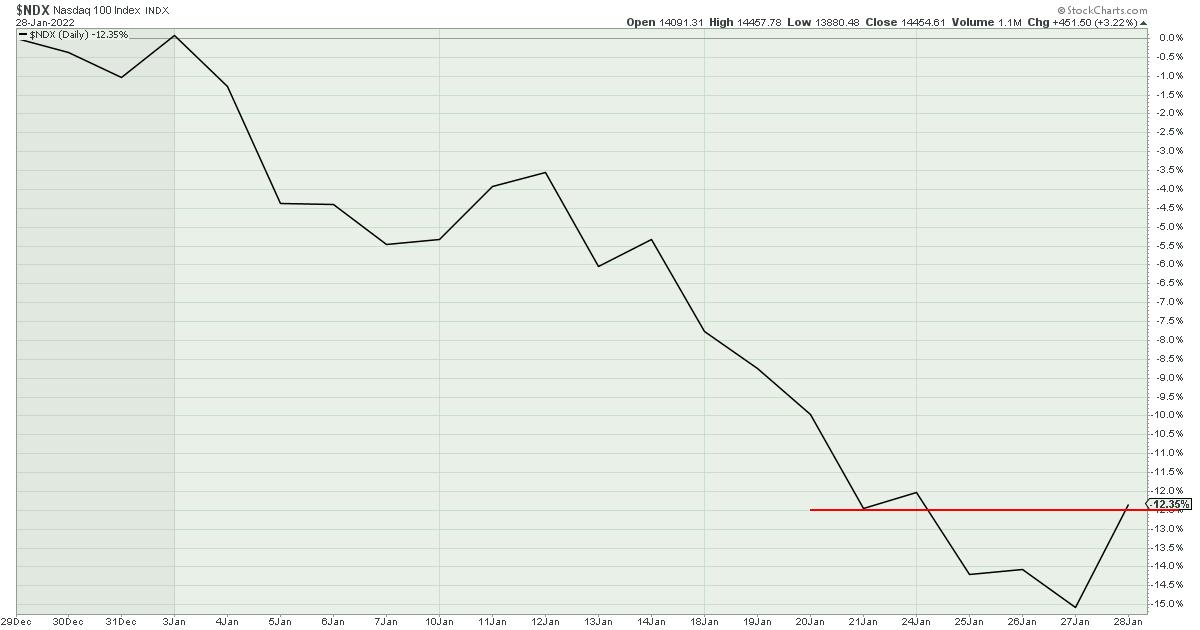
The second chart is the $SPX. This chart is a little stronger, as we had the highest close of the week and it was above last Friday's close.
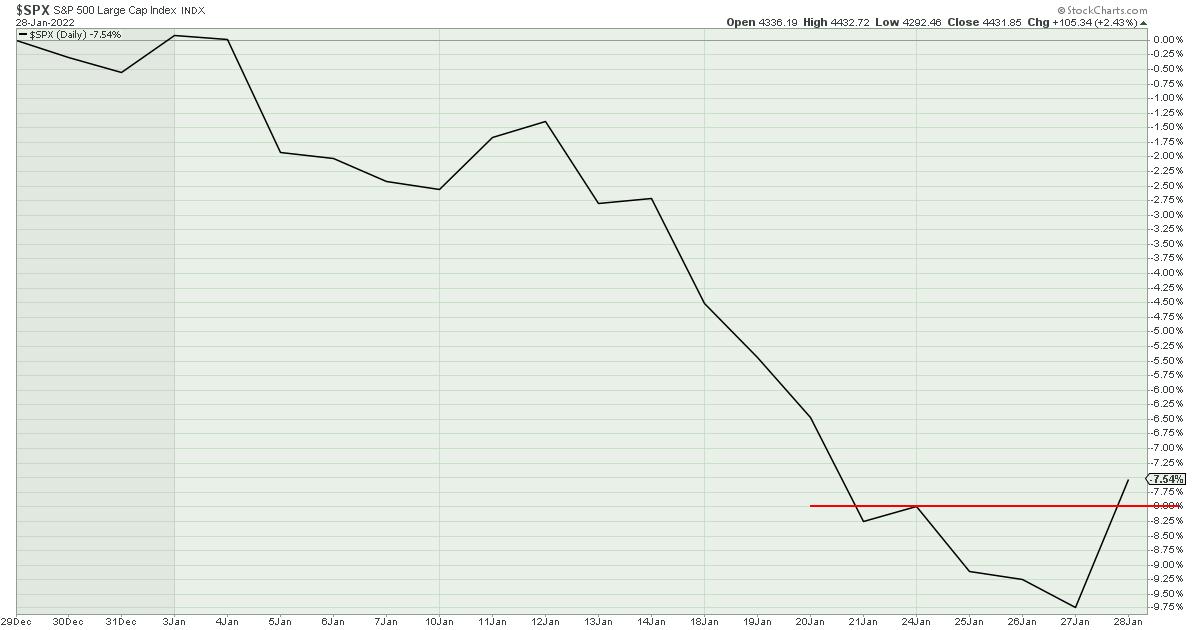
Both charts has some steep declines, and the only way to reverse that is to start making some higher closes. Friday was the first step!
As I mentioned earlier, AMD is trying to hold the long trend line. NVDA's chart broke an important uptrend line last week; AMD followed this week. We'll need to see some serious buying if these semiconductor charts are going to start to make bases. That break is on a 4-year trend on the AMD chart below, which is a big deal. Watch to see if it lasts through to next week.
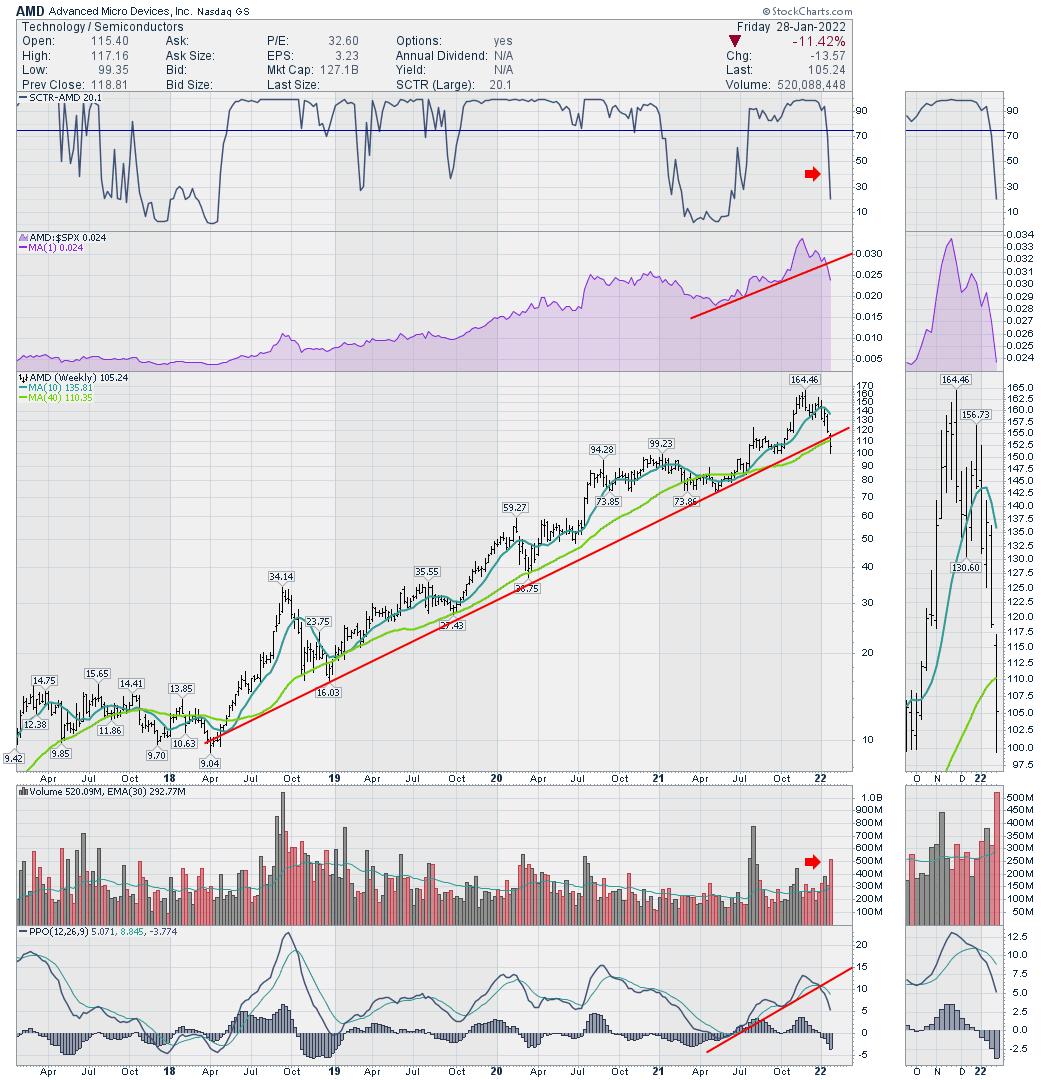
Tesla is a real difficult chart for me as a chartist. The most important chart line for me this week on the chart below is the relative strength chart, shown in purple. If Tesla starts to underperform the $SPX, it will break this relative strength line. Institutional investors like to find stocks outperforming the index. When they start underperforming, they start selling the stock and buy something else that is outperforming. This is a very important line on the chart. Looking at the PPO on the lower panel, Tesla has a significantly lower high compared to January. This is important if the investors in Tesla are lacking interest to buy up the stock.
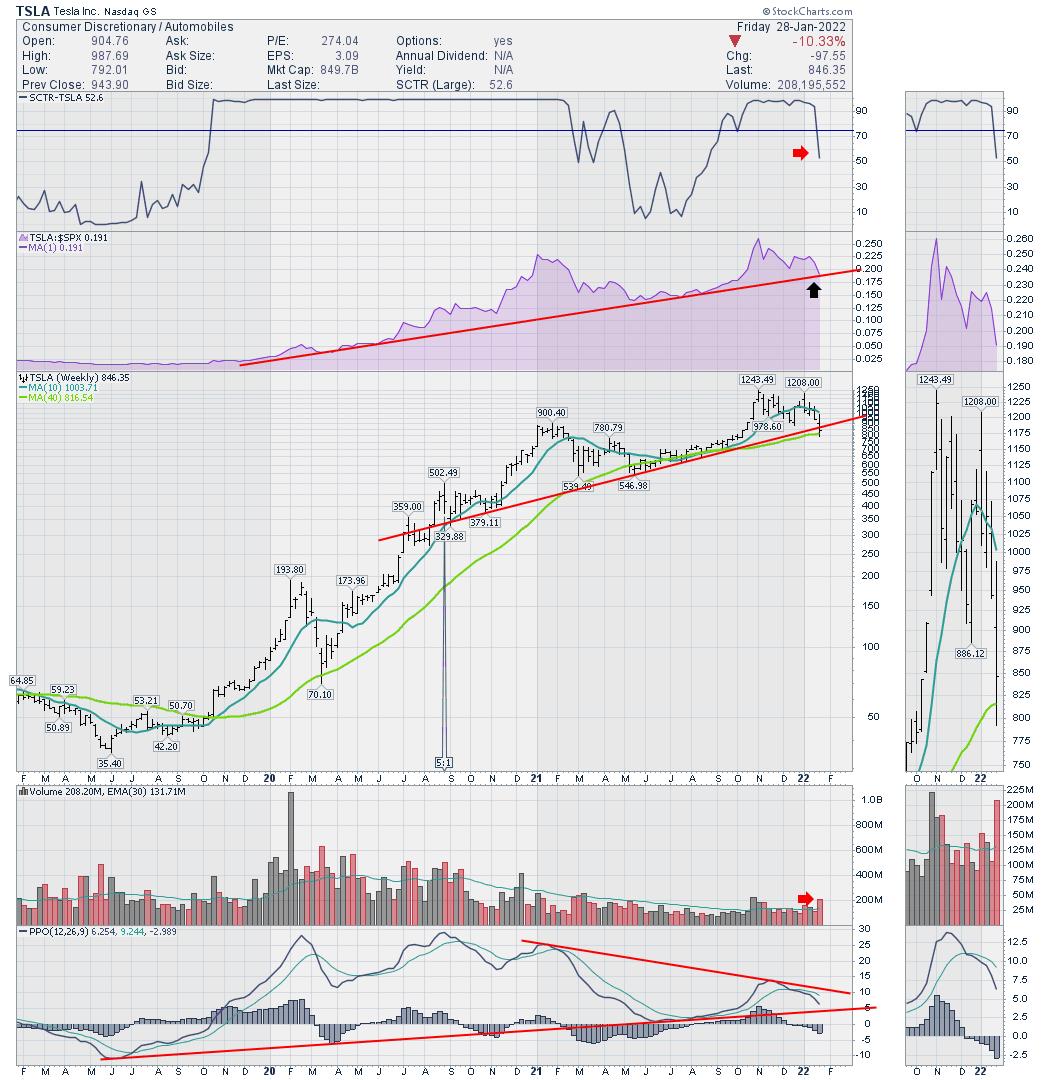
To wrap up the week, I would say the Friday price action on the indexes was bullish. On some of the important stocks, less so. Having AMD and TSLA both close down double digits while the indexes closed above last Friday shows some significant loss of relative strength.
There will be lots of debates as to how strong the market can rally, but I like the fact that the Fed meeting is behind us. We know the Fed is going to raise in March. For me, we got the first step Friday, a higher weekly close.
|
| READ ONLINE → |
|
|
|
| Mish's Market Minute |
| Should We Start Watching Noncyclical Stocks? |
| by Mish Schneider |
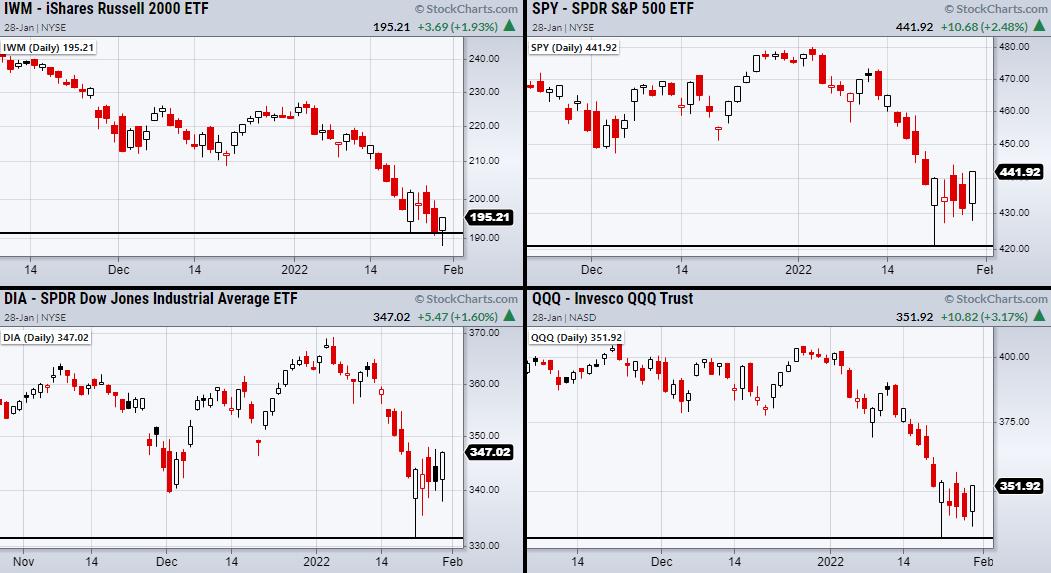
The past week has been very challenging, as the market can't seem to pick a direction. Though short-term momentum has more overhead pressure, even the bears have had difficulty shorting the choppy price action. In times like this, it can be helpful to take a step back, watch key price levels in the major indices and relate them to trading levels within our personal trades. Sometimes you can even find trades that are going against the short-term trend. With that said, this can also be a great time to start watching areas, like non-cyclical stocks.
In the above chart of the four major indices, only the Russell 2000 (IWM) has broken its support from Monday's trading range. However, it was able to close over the low from the 24th at $191.23. Other indices, including the S&P 500 (SPY), Dow Jones (DIA) and the Nasdaq 100 (QQQ) are well within Monday's range and ended the week over or near last Monday's high.
Though Mish has pointed to stagflation for a while now, it continues to play a role through 2022 and can lead us towards areas to focus on. For instance, non-cyclical companies, which people will continue to buy from no matter the economic situation.
Two of the sectors we've been watching are medical and parts of the retail space. For the medical space, we've been watching Vertex Pharmaceuticals (VRTX); for the retail space, Levi Strauss & Co. (LEVI). While VRTX closed a whopping +6% on Friday, its strong upward trend means it's worth watching for another trade setup. When it comes to LEVI, it will need to hold its 10-day moving average at $21.72. However, even noncyclical stocks are subject to overall market pressure if the indices begin to break down. Therefore, we should keep an eye on the major indices to hold over last Monday's low from January 24th.
Follow Mish on Twitter @marketminute for stock picks and more. Follow Mish on Instagram (mishschneider) for daily morning videos. To see updated media clips, click here.
With the market under pressure, stocks that outperform after earnings reports can often give you great trading ideas of where to go. On this week's edition of StockCharts TV's Mish's Market Minute, Mish dives into an assortment of stocks that have already reported or are about to report to show you the "good, the bad, and the ugly" of earnings trades.
ETF Summary
- S&P 500 (SPY): 442.42 the 200-DMA to clear.
- Russell 2000 (IWM): 208.76 resistance. 191.23 minor support.
- Dow (DIA): Flirting with the 10-DMA at 346.99.
- Nasdaq (QQQ): Like this to hold over 350.
- KRE (Regional Banks): 68.74 support the 200-DMA.
- SMH (Semiconductors): 257.24 needs to hold.
- IYT (Transportation): 248.85 support to hold.
- IBB (Biotechnology): 122.50 support.
- XRT (Retail): 75.62 low to hold.
Forrest Crist-Ruiz
MarketGauge.com
Assistant Director of Trading Research and Education
|
| READ ONLINE → |
|
|
|
| MORE ARTICLES → |
|
 Chart 1
Chart 1 Chart 2
Chart 2 Chart 3
Chart 3 Chart 4
Chart 4 Chart 5
Chart 5 Chart 6
Chart 6
















 Profits are the product of practicing a persistent pilgrimage towards perfecting your sell disciplines. To paraphrase a sports cliche, without an exceptional defense you won't win championships. Michael Jordan has unequivocally stated that without the defensive wizardry of Dennis Rodman, the Chicago Bulls would not have been world champions in 1996, '97 or '98.
Profits are the product of practicing a persistent pilgrimage towards perfecting your sell disciplines. To paraphrase a sports cliche, without an exceptional defense you won't win championships. Michael Jordan has unequivocally stated that without the defensive wizardry of Dennis Rodman, the Chicago Bulls would not have been world champions in 1996, '97 or '98.






















